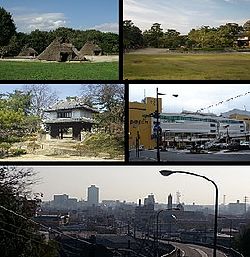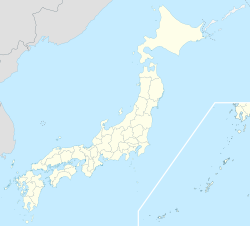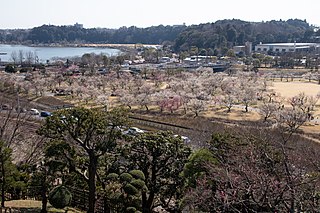
Ibaraki Prefecture is a prefecture of Japan located in the Kantō region of Honshu. Ibaraki Prefecture has a population of 2,828,086 and has a geographic area of 6,097.19 square kilometres. Ibaraki Prefecture borders Fukushima Prefecture to the north, Tochigi Prefecture to the northwest, Saitama Prefecture to the southwest, Chiba Prefecture to the south, and the Pacific Ocean to the east.

Ishioka is a city located in Ibaraki Prefecture, Japan. As of 1 January 2024, the city had an estimated population of 70,124 in 28,892 households and a population density of 325 persons per km2. The percentage of the population aged over 65 was 33.5%. The total area of the city is 215.53 square kilometres (83.22 sq mi).

Ryūgasaki is a city located in Ibaraki Prefecture, Japan. As of 1 January 2024, the city had an estimated population of 75,212 in 33,421 households and a population density of 958 persons per km². The percentage of the population aged over 65 was 31.1% in July 2020. The total area of the city is 78.59 square kilometres (30.34 sq mi).

Shimotsuma is a city located in Ibaraki Prefecture, Japan. As of 1 January 2024, the city had an estimated population of 41,621 in 17,294 households and a population density of 515 persons per km². The percentage of the population aged over 65 was 29.0%. The total area of the city is 80.88 square kilometres (31.23 sq mi).

Kitaibaraki is a city in Ibaraki Prefecture, Japan. As of 1 July 2020, the city had an estimated population of 41,750 in 17,034 households and a population density of 220 persons per km2. The percentage of the population aged over 65 was 34.6%. The total area of the city is 186.80 square kilometres (72.12 sq mi).

Kasama is a city located in Ibaraki Prefecture, Japan. Kasama is the home of Kasama ware and known for Japanese chestnuts. As of 1 July 2020, the city had an estimated population of 73,805 in 29,362 households and a population density of 307 persons per km². The percentage of the population aged over 65 was 32.2%. The total area of the city is 240.400 square kilometres (92.819 sq mi).
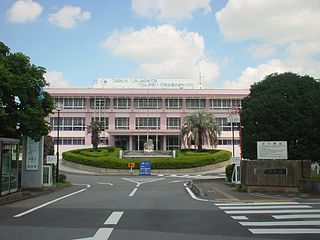
Ushiku is a city located in Ibaraki Prefecture, Japan. As of 1 January 2024, the city had an estimated population of 83,826 in 36,380 households and a population density of 1423 persons per km2. The percentage of the population aged over 65 was 29.5%. The total area of the city is 58.92 square kilometres (22.75 sq mi).

Abiko is a city located in Chiba Prefecture, Japan. As of 1 February 2024, the city had an estimated population of 131,183 in 62,193 households and a population density of 3000 persons per km2. The total area of the city is 43.19 square kilometres (16.68 sq mi).

Hitachi Province was an old province of Japan in the area of Ibaraki Prefecture. It was sometimes called Jōshū (常州). Hitachi Province bordered on Shimōsa, Shimotsuke, and Mutsu Provinces. Generally, its northern border was with Mutsu.
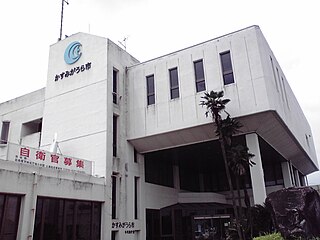
Kasumigaura is a city located in Ibaraki Prefecture, Japan. As of 1 July 2020, the city had an estimated population of 40,254 in 15,839 households and a population density of 257 persons per km². The percentage of the population aged over 65 was 32.0%. The total area of the city is 156.60 square kilometres (60.46 sq mi).. The city takes its name from the nearby lake, Lake Kasumigaura. The city has the distinction of having the longest name in Japan, together with Ichikikushikino, Kagoshima Prefecture and Tsukubamirai. Much of the city is within the borders of the Suigō-Tsukuba Quasi-National Park.
Niihari was a district located in Ibaraki, Japan. The district was dissolved on March 27, 2006.

Chikusei is a city located in Ibaraki Prefecture, Japan. As of 1 January 2024, the city had an estimated population of 98,031 in 39,075 households and a population density of 478 persons per km2. The percentage of the population aged over 65 was 31.2%. The total area of the city is 205.30 square kilometres (79.27 sq mi).

Tsukubamirai is a city located in Ibaraki Prefecture, Japan. As of 1 October 2020, the city had an estimated population of 51,035 in 20,030 households and a population density of 645 persons per km². The percentage of the population aged over 65 was 26.3%. The total area of the city is 79.16 square kilometres (30.56 sq mi).

Omitama is a city located in Ibaraki Prefecture, Japan. As of 1 July 2020, the city had an estimated population of 48,776 in 18,311 households and a population density of 337 persons per km2. The percentage of the population aged over 65 was 30.0%. The total area of the city is 144.74 square kilometres (55.88 sq mi).

Tsukuba is a city located in Ibaraki Prefecture, Japan. As of January 1, 2024, the city had an estimated population of 256,526 in 121,001 households and a population density of 900 persons per km2. The percentage of the population aged over 65 was 20.3%. The total area of the city is 283.72 square kilometres (109.54 sq mi). It is known as the location of the Tsukuba Science City, a planned science park developed in the 1960s.
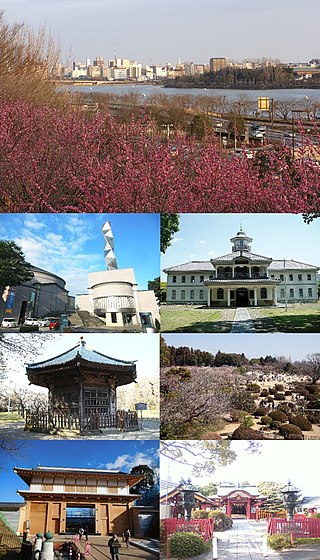
Mito is the capital city of Ibaraki Prefecture, in the northern Kantō region of Japan. As of 1 January 2024, the city had an estimated population of 268,036 in 126,055 households and a population density of 1,233 persons per km2. The percentage of the population aged over 65 was 27.1%. The total area of the city is 217.32 square kilometres (83.91 sq mi).

Tsuchiura Station is a railway station in the city of Tsuchiura, Ibaraki Prefecture, Japan, operated by East Japan Railway Company. It is also a freight depot for the Japan Freight Railway Company.

Tsuchiura Domain was a feudal domain under the Tokugawa shogunate of Edo period Japan, located in Hitachi Province, Japan. It was centered on Tsuchiura Castle in what is now the city of Tsuchiura, Ibaraki. It was ruled for much of its history by the Tsuchiya clan.

Ibaraki 6th district is a single-member constituency of the House of Representatives in the national Diet of Japan located in Ibaraki Prefecture.
